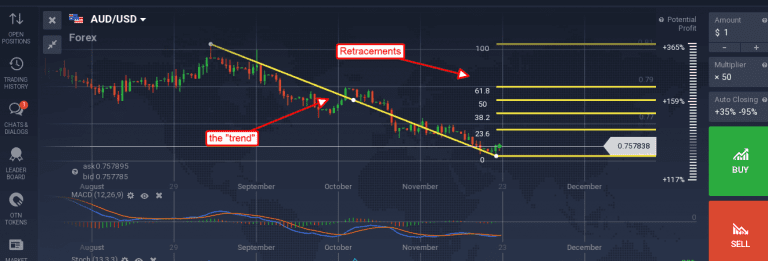Fibonacci is one of the most widely respected mathematicians in history. His descriptions and practical applications of the Golden Ratio remain with us today and are the very basis of many different forms of technical analysis. It only makes sense, right? The Golden Ratio describes the relationships between living things, and the market is just that: a living beast, a mob. For a person, arm span is relative to height is relative to leg length, and so on in a manner that is time and time again seen.
The most common use of Fibonacci in technical analysis is the Fibonacci Retracement. This is a drawing tool used to measure and divide up and down trends. The basic principle is this: within a trend there will be corrections, and those corrections can be categorized by their depth in relation to the overall trend. For example, a trend from point A to point B is measured with the Fibonacci Tool. The tool projects target levels within that trend based on the Golden Ratio. These targets are where traders may expect to find potential entry points for trades. Below you will find two key principles to keep in mind when using Fibonacci.
- Key Principle – Fibonacci Retracement levels are not signals — they are price targets where signals may be found. A move to a retracement level may result in continuation or reversal depending on underlying conditions.
- Key Principle – Fibonacci Retracement are not exact targets, but rather they are general areas in which a signal may be found or an area in which signals could be considered to be “significant.” A bullish candle may mean completely different things if it forms below, at or above a retracement level.
Let’s take a look at an example of this strategy. At this moment, the AUD/USD is presenting a perfect opportunity to use this tool. The pair has hit what may or may not be “the bottom,” but that doesn’t matter so long as it is “a” bottom the Fibonacci Tool can help us figure it out. To begin, use the tool to draw a line from the highest high preceding the recent down trend to the most recent low, as that is the trend we are measuring. In the chart below, you can see that this results in 5 retracements; 23.6%, 38.2%, 50%, 61.8% and 100% of the measured trend.

Now that prices are bouncing/consolidating, we can use the retracement lines as targets for entry and exit points.
Here are a couple of possible scenarios:
- If the prevailing down trend is strong, prices are likely to remain low and at/near the 0% retracement line. If this is happening, look for signals to occur at this line. If it continues to act as support and a bullish signal is generated by candles and/or stochastic, MACD or RSI playing calls is the best thing to do. If bearish signals begin to develop and/or the 0% retracement line is broken the down trend is likely to continue. Use the 0% in this case as a starting point for bearish trades when confirmed by other signals.
- If a correction is able to form, prices are likely to move up to test the first line, the 23.6% retracement level. If this happens use this line as your resistance target. If price action begins to form bearish signals below, at or slightly above this line, you can expect to see it move lower to retest the 0% level. If price action is able to move above the line or is making bullish signals at or just below it, you can expect to see a move to the next higher retracement.
- If price is able to move above the 23.6% line, we can expect to see it move up to the next higher retracement, the 38.2% level. Likewise, a break of the 38.2% level would indicate a move to the 50%. If bearish signals were to occur at or near either of these lines a retest of the previously broken line should be expected.
- The 50% level is a very important one. In general, even the strongest corrections are halted at this level. A break above it is an indication of full reversal and automatically brings the 100% level into play. At that point traders would look for bullish signals of confirmation along the 50% line.

- If the correction meets resistance at one of these retracement levels, we can expect to see the previously broken line retested as support. Bullish action would confirm the support and result in a bounce, a break below would likely take prices down to the next lower retracement.
Ready to incorporate Fibonacci tools into your trading strategy? Hopefully this article provided helpful pointers for you to try it out. Don’t forget you can always use your demo account to get acquainted with new tools and features. Fibonacci is just one of the many tactics out there to help you reach your trading potential.

